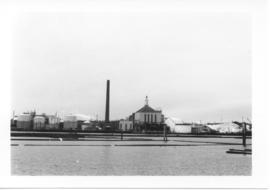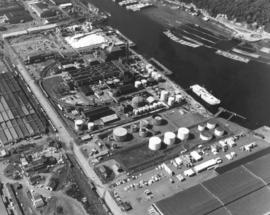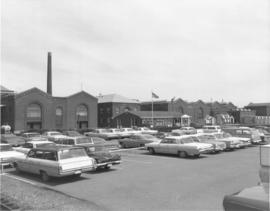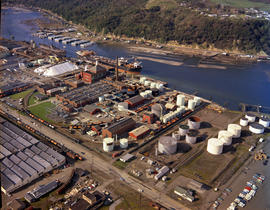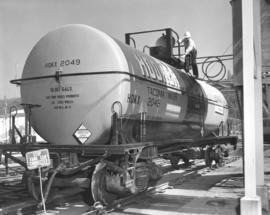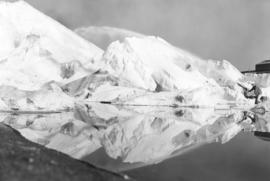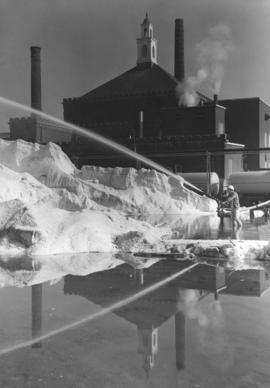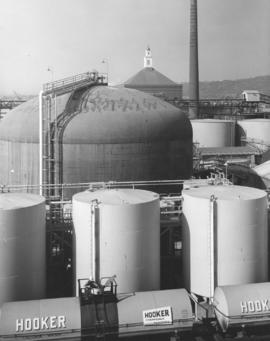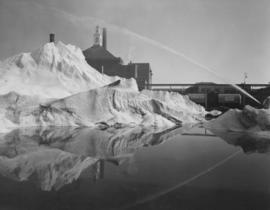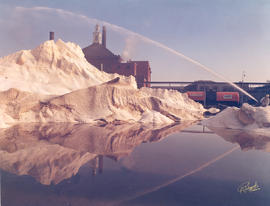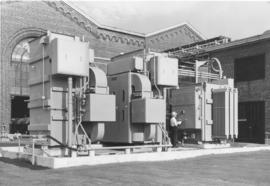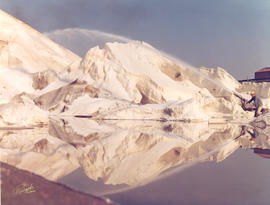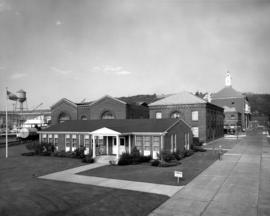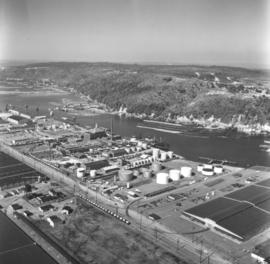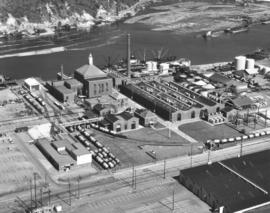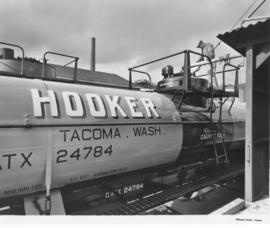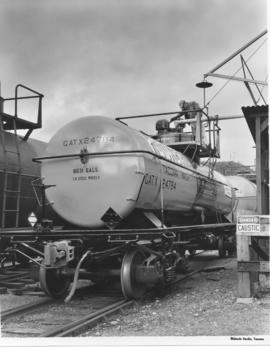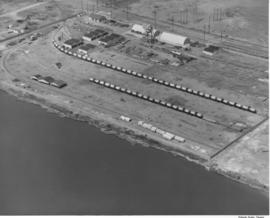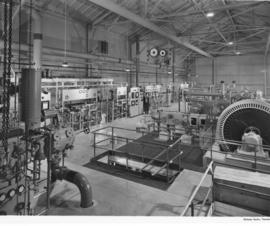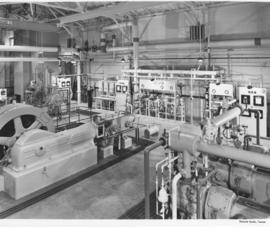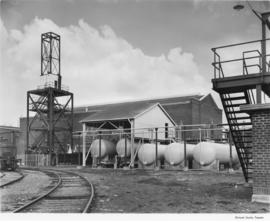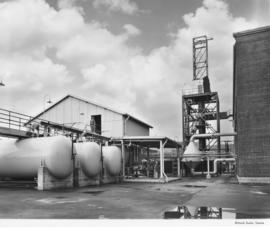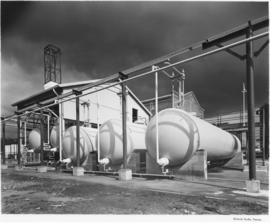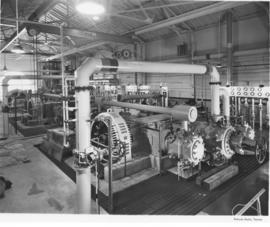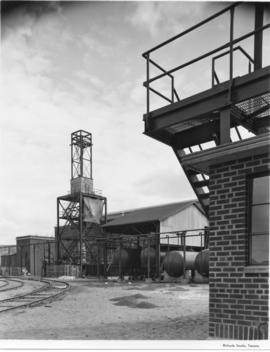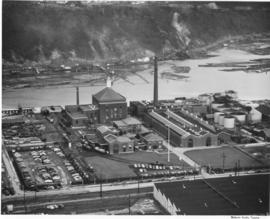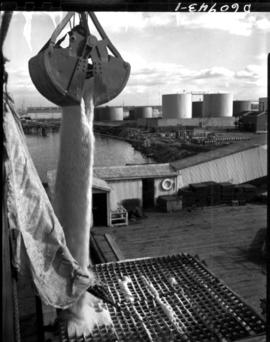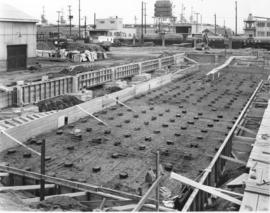- Item
- 1977
Showing 68 results
Collections68 results with digital objects Show results with digital objects
- Item
- 1970-05-26
Part of Richards Studio Photographs
Aerial view on May 26, 1970, of the Tacoma industrial Tideflats, featuring Hooker Chemical and Hylebos Waterway. By 1970, Hooker had been in Tacoma for 41 years. It had begun in 1929 with production of 13 tons of chlorine a day and a work crew of 40. In 1969, production had increased to 400 tons with the aid of 300 employees. Hooker was the first to produce caustic soda. Chlorine and caustic soda were sold mostly to the pulp/paper industry in the Pacific Northwest. By 1969, Hooker Chemical was a wholly owned subsidiary of Occidental Petroleum. (TNT 2-2-69, B-8 -article) Photograph ordered by Hylebos Industries, Inc.
Aerial views; Hooker Electrochemical Co. (Tacoma); Chemical industry--Tacoma--1970-1980; Industrial facilities--Tacoma--1970-1980; Hylebos Waterway (Tacoma);
- Item
- 1969
- Item
- 1967-05-02
Part of Richards Studio Photographs
1967 Richards Studio stock file. May 2, 1967, aerial view in color of sprawling Hooker Chemical plant, 605 Alexander Ave., in the Tacoma tideflats. A ship is docked on the Hylebos Waterway next to the facility, ready to load and unload Hooker products. Easy access to water, rail and roadways was a factor in locating the large plant in Tacoma in 1928. Hooker was one of the primary suppliers to Pacific Northwest pulp and paper companies of chemicals used to bleach and refine wood pulp. Later it would also manufacture soap and refine petroleum products.
Aerial photographs; Hooker Electrochemical Co. (Tacoma); Chemical industry--Tacoma--1960-1970; Industrial facilities--Tacoma--1960-1970; Hylebos Waterway (Tacoma);
- Item
- 1965-08-25
Part of Richards Studio Photographs
A Hooker Chemical chlorine tank car awaits attention on the track outside the Tacoma plant on August 25, 1965. The tank holds 10,817 gallons. Photograph ordered by Hooker Chemical. TPL-6608
Storage tanks--Tacoma; Hooker Electrochemical Co. (Tacoma);
- Item
- 1964-10
Part of Richards Studio Photographs
Hooker Chemical Co. operations. Although this hard hatted employee appears to be maneuvering his machine to spray over a mountain of snow, he is actually adding to the enormous stockpile of salt on the salt pad at Hooker Chemical Co. The pile of salt is reflected in the adjoining pond of water. Photograph ordered by Hooker Chemical for use in annual report.
Hooker Electrochemical Co. (Tacoma); Chemical industry--Tacoma--1960-1970; Industrial facilities--Tacoma--1960-1970;
- Item
- 1964-10
Part of Richards Studio Photographs
Hooker Chemical Co. operations. Knee deep in water on a cool day in October, 1964, a Hooker Chemical Co. employee uses a sprayer on giant piles of salt. The Georgian-style plant with steeple is in the background. Photograph ordered by Hooker Chemical for annual report.
Hooker Electrochemical Co. (Tacoma); Chemical industry--Tacoma--1960-1970; Industrial facilities--Tacoma--1960-1970;
- Item
- 1964-10
Part of Richards Studio Photographs
Hooker Chemical operations. October, 1964, view of large storage tank believed to be liquid ammonia holding tank on Hooker Chemical property. Smaller tanks surround it. A new storage tank was built for a program of marketing agricultural ammonia as a fertilizer. Photograph ordered by Hooker Chemical for annual report. TPL-6607
Hooker Electrochemical Co. (Tacoma); Chemical industry--Tacoma--1960-1970; Industrial facilities--Tacoma--1960-1970; Storage tanks--Tacoma;
- Item
- 1964-10
Part of Richards Studio Photographs
Hooker Chemical operations. Another in a series of October, 1964, photographs of Hooker Chemical Co. operations at the company's Tideflats site. Worker in hard hat pictured in the act of spraying onto the enormous mound of salt. Salt, steeple on building and smokestack reflected in the adjoining pond. Hooker Chemical in Tacoma was the headquarters of the company's Western Division. According to the company's 1964 annual report, Hooker's role as a major supplier of chemicals to the pulp and paper industry substantially increased during the year and it was anticipated that sales would continue to rise. Photograph ordered by Hooker Chemical for annual report. (1964 Hooker Chemical Corp. annual report, p. 10)
Hooker Electrochemical Co. (Tacoma); Chemical industry--Tacoma--1960-1970; Industrial facilities--Tacoma--1960-1970;
- Item
- 1964-10
Part of Richards Studio Photographs
Hooker Chemical Co. operations. Color photograph taken in October, 1964, of Hooker Chemical employee in hard hat spraying large piles of salt on company property. This particular scene is very similar to D142933-15. The salt is reflected in the adjoining pool of water. The huge pulp and paper industry in the Pacific Northwest created large new demands for pulp bleaching chemicals. Photograph ordered by Hooker Chemical Co. for annual report. (1964 Hooker Chemical Corp. annual report, p. 10)
Hooker Electrochemical Co. (Tacoma); Chemical industry--Tacoma--1960-1970; Industrial facilities--Tacoma--1960-1970;
- Item
- 1964-10
Part of Richards Studio Photographs
Hooker Chemical operations. A Hooker Chemical Co. employee appears to be monitoring the gauge on the large machinery outside the company plant in October, 1964. Photograph ordered by Hooker Chemical Co. for annual report.
Hooker Electrochemical Co. (Tacoma); Chemical industry--Tacoma--1960-1970; Industrial facilities--Tacoma--1960-1970; Machinery;
- Item
- 1964-10
Part of Richards Studio Photographs
Hooker Chemical Co. operations. Although this resembles mounds of snow reflected in a clear pool of water, the piles are actually made of salt. Hooker Chemical Co. used tons of salt in their daily operations. A Hooker employee is pictured above in October of 1964 spraying water onto the salt piles. ALBUM 15.
Hooker Electrochemical Co. (Tacoma); Chemical industry--Tacoma--1960-1970;
- Item
- 1964-10
Part of Richards Studio Photographs
Hooker Chemical Co. operations. View of brick one-story office for Hooker Chemical Co. in October, 1964. Unlike many faceless concrete industrial facilities, the older plant buildings were built in the Georgian style. Even the newer structures, such as the office building above, retained a classic facade. The Hooker plant was opened on February 16, 1929. It retained the Hooker name until 1982 when it changed its name to Occidental Chemical Corp. Photograph ordered by Hooker Chemical for annual report.
Hooker Electrochemical Co. (Tacoma); Chemical industry--Tacoma--1960-1970; Industrial facilities--Tacoma--1960-1970;
- Item
- 1960
Part of Richards Studio Photographs
ca. 1960. Aerial photograph of Hooker Electrochemical plant on Alexander Avenue in the Tideflats ca. 1960 Richards stock footage. Built on the site of the old Foundation shipyard, the Hooker plant opened in February, 1929. It played a leading part in Tacoma's industrial history for over sixty years. Company name was changed without comment to Occidental Chemical Corp. in 1982.
Hooker Electrochemical Co. (Tacoma); Chemical industry--Tacoma--1960-1970; Aerial photographs;
- Item
- 1960
Part of Richards Studio Photographs
ca. 1960. Richards stock footage. Aerial photograph taken in 1960 of the Hooker Electrochemical Co. plant located at 605 Alexander Avenue on the Tacoma Tideflats. A ship is docked at the company dock on the Hylebos Waterway, ready to transport and transfer Hooker products. A railroad spur running through the facility also made transportation of Hooker chemicals an easier task.
Aerial photographs; Hooker Electrochemical Co. (Tacoma); Chemical industry--Tacoma--1960-1970; Hylebos Waterway (Tacoma); Harbors--Tacoma;
- Item
- 1959-04-03
Part of Richards Studio Photographs
Railroad tank car being loaded with caustic soda at Hooker Chemicals. Hooker Electrochemical was a large producer of chlorine and caustic soda, supplying the Pacific Northwest's pulp and paper industry.
Hooker Electrochemical Co. (Tacoma); Chemical industry--Tacoma--1950-1960; Industrial facilities--Tacoma--1950-1960; Railroad tank cars--Tacoma--1950-1960;
- Item
- 1959-04-03
Part of Richards Studio Photographs
Railroad tank car being loaded at Hooker Chemicals. The sign cautions "Danger, Caustic." Hooker Electrochemical was a large producer of chlorine and caustic soda, supplying the Pacific Northwest's pulp and paper industry. According to the tank's markings, it hold 8031 gallons of caustic soda.
Hooker Electrochemical Co. (Tacoma); Chemical industry--Tacoma--1950-1960; Industrial facilities--Tacoma--1950-1960; Railroad tank cars--Tacoma--1950-1960;
- Item
- 1957-07-24
Part of Richards Studio Photographs
An aerial photograph of the Hooker Electrochemical plant in the Tideflats was taken on July 24, 1957, for possible order by the company. Storage tanks appear to be loaded on railroad cars on two parallel tracks. Hooker was the second chlor-alkali plant in the United States and the first caustic soda plant in the Pacific Northwest. This was apparently an aerial view of an area of Hooker Electrochemical Co. on Industrial Waterway.
Aerial photographs; Hooker Electrochemical Co. (Tacoma); Chemical industry--Tacoma--1950-1960;
- Item
- 1952
Part of Richards Studio Photographs
ca. 1952. Control room for production of anhydrous ammonia at the new ammonia plant, Hooker Electrochemical. Anhydrous ammonia is ammonia in the form of a gas. It is composed of three parts hydrogen to one of nitrogen. The hydrogen is obtained from electrolytic cells, which convert salt brine into caustic soda, chlorine and hydrogen. The rock salt used is obtained from the San Francisco bay area solar evaporation ponds. The nitrogen is obtained from the air by liquefying equipment manufactured by L'Aire Liquide of Montreal. (TNT 10-19-1952)
Hooker Electrochemical Co. (Tacoma); Factories--Tacoma--1950-1960; Chemical industry--Tacoma--1950-1960;
- Item
- 1952
Part of Richards Studio Photographs
ca. 1952. Interiors new anhydrous ammonia plant, Hooker Electrochemical. The new $2 million plant was completed in May of 1952. The plant had an output of 40 tons every 24 hours. Eighteen men were employed in the plant, which operated 24 hours a day, seven days a week. The plant began operation in June of 1952 with its entire production already contracted for. Plans were made immediately for a $6 million dollar expansion. (TNT 10-19-1952)
Hooker Electrochemical Co. (Tacoma); Factories--Tacoma--1950-1960; Chemical industry--Tacoma--1950-1960;
- Item
- 1952-05-01
Part of Richards Studio Photographs
Exterior at new ammonia plant, Hooker Electrochemical. In the plant, hydrogen and nitrogen are mixed in the proper proportion for anhydrous ammonia, subjected to 5,000 pounds to a square inch pressure and then sent to a converter and combined to make the gas. The ammonia is placed in storage tanks outside the plant to await shipment. Shipment is done entirely by railroad tank car. Each car holds 26 tons. (TNT 10-19-1952)
Hooker Electrochemical Co. (Tacoma); Factories--Tacoma--1950-1960; Chemical industry--Tacoma--1950-1960;
- Item
- 1952-05-01
Part of Richards Studio Photographs
Exterior at new anhydrous ammonia plant, Hooker Electrochemical, completed in May of 1952. Design and erection of the plant were supervised by the Chemical Construction Corporation. The general contractor for the construction of buildings and erection of equipment was Roy T. Earley Co. of Tacoma. The plant went into production in June of 1952, with a output of 40 tons every 24 hours. It operated 24 hours a day, seven days a week. (TNT 10-19-1952)
Hooker Electrochemical Co. (Tacoma); Factories--Tacoma--1950-1960; Chemical industry--Tacoma--1950-1960;
- Item
- 1952-05-01
Part of Richards Studio Photographs
Exteriors new anhydrous ammonia plant, Hooker Electrochemical, completed in May of 1952. Hooker also produced liquid chlorine, caustic soda and muriatic acid. The ammonia plant began operation in June of 1952 with an output of 40 tons every 24 hours. It was immediately deemed too small and scheduled for a $6 million expansion, which would increase production by 50 per cent. The plant operated 24 hours a day, 7 days a week and employed 18 men. (TNT 10-19-1952)
Hooker Electrochemical Co. (Tacoma); Factories--Tacoma--1950-1960; Chemical industry--Tacoma--1950-1960;
- Item
- 1952-04-11
Part of Richards Studio Photographs
Interior of new ammonia plant at Hooker Electrochemical. The $2 million anhydrous ammonia plant was completed in May of 1952. Anhydrous ammonia is ammonia in the form of a gas. It is used by firms such as the Pacific Northwest's pulp and paper mills and fertilizer and explosives manufacturing companies. By completion of the plant, the entire production was already contracted for and the plant was set for another $6 million dollar expansion to be competed by the fall of 1953. (TNT 10-19-1952)
Hooker Electrochemical Co. (Tacoma); Chemical industry--Tacoma--1950-1960;
- Item
- 1952-04-11
Part of Richards Studio Photographs
Exterior of new anhydrous ammonia plant at Hooker Electrochemical, completed in May of 1952. The ammonia produced here was used by the Northwest's paper and pulp mills and fertilizer and explosive manufacturers. It was shipped entirely by tank car, each car held 26 tons. On completion of the plant, the entire production of 40 tons every 24 hours was already contracted for. The plant was slated for an immediate $6 million dollar expansion that would increase production by half. (TNT 10-19-1952)
Hooker Electrochemical Co. (Tacoma); Chemical industry--Tacoma--1950-1960;
- Item
- 1952-04-11
Part of Richards Studio Photographs
Exterior of new anhydrous ammonia plant at Hooker Electrochemical, completed in May of 1952. Ammonia in gaseous form is composed of three parts of hydrogen to one of nitrogen. In the plant, the hydrogen and nitrogen are mixed in the proper proportion, subjected to 5,000 pounds to a square inch pressure and then sent to a converter and combined to make ammonia. The ammonia is placed in storage tanks outside the plant to await shipment by tank car. (TNT 10-19-1952)
Hooker Electrochemical Co. (Tacoma); Chemical industry--Tacoma--1950-1960;
- Item
- 1952-01-09
Part of Richards Studio Photographs
An aerial view of the plant facility for Hooker Electrochemical Company located at 605 Alexander Avenue on the Tacoma tideflats. The Hylebos Waterway provided excellent accessibility with a company dock and a railroad spur running through the facility enhanced transportation even further. The Port of Tacoma sold an additional 20-acre site to Hooker Electrochemical in December 1951 for $56,400 according to George Osgood, manager of the Port. The property, including a 1,200-foot frontage on the Port-Industrial waterway, was to be used for further expansion of the chemical firm's Tacoma plant. (TNT, 12/16/1951, p.1)
Aerial photographs; Hooker Electrochemical Co. (Tacoma); Logs; Hylebos Waterway (Tacoma); Harbors--Tacoma; Factories--Tacoma--1940-1950; Chemical industry--Tacoma--1950-1960;
- Item
- 1951-09-10
Part of Richards Studio Photographs
Conveyor Link Belt operation at Hooker Chemical Company, Tacoma. For Link Belt Company. Long conveyor moves chemicals in corregated building. Part of series taken on September 10, 1951.
Conveying systems--Tacoma--1950-1960; Belts & belting (Equipment); Hooker Electrochemical Co. (Tacoma); Chemical industry--Tacoma--1950-1960;
- Item
- 1951-09-10
Part of Richards Studio Photographs
Conveyor Link Belt operation at Hooker Chemical Company, Tacoma. For Link Belt Company. Crane operated shovel dumps chemicals into open grate. Storage tanks at edge of water in background. Part of series taken on September 10, 1951.
Hoisting machinery; Hooker Electrochemical Co. (Tacoma); Chemical industry--Tacoma--1950-1960; Storage tanks--Tacoma;
- Item
- 1951-08-27
Part of Richards Studio Photographs
Expansion continues at the Hooker Electrochemical Company's Tideflats plant in August, 1951. Steel reinforcing and footing for a new building are being installed. Hooker began operations in Tacoma in 1929 and constantly remodeled and expanded in order to handle their growing business. Along with Pennsylvania Salt Manufacturing Company of Washington, Hooker supplied the Pacific Northwest pulp and paper industry with caustic soda and chlorine. Hooker tank cars can be seen in the photograph's background; they were one method of shipping Hooker products to their customers.
Hooker Electrochemical Co. (Tacoma); Chemical industry--Tacoma--1950-1960; Industrial facilities--Tacoma--1950-1960; Railroad tank cars--Tacoma--1950-1960;
